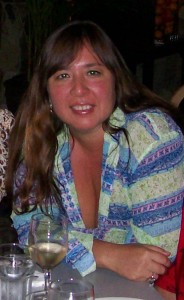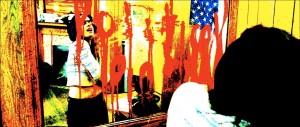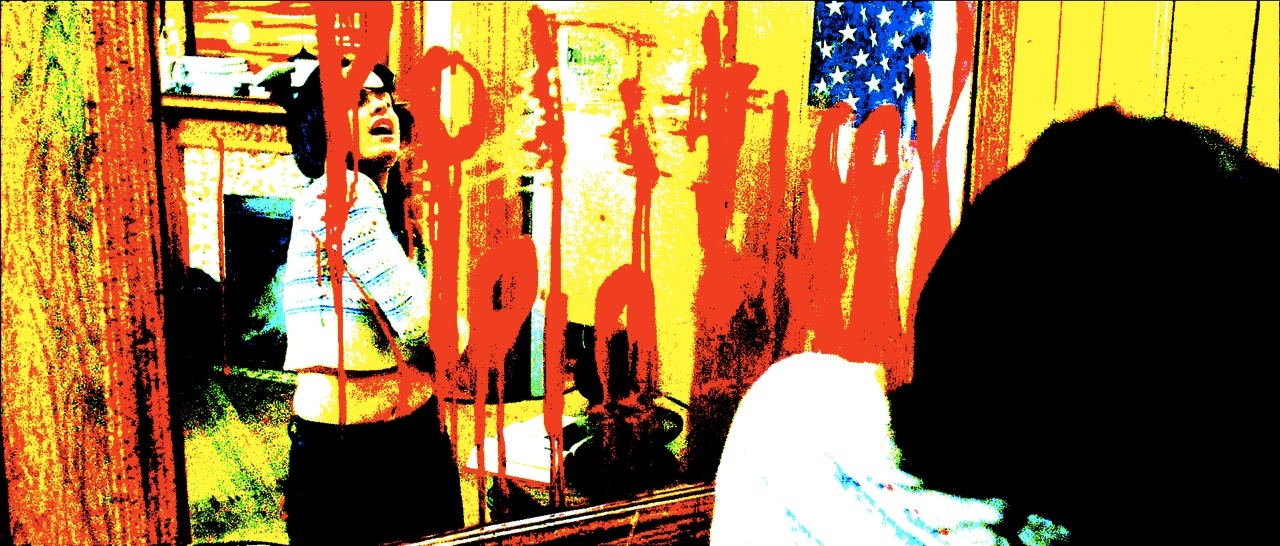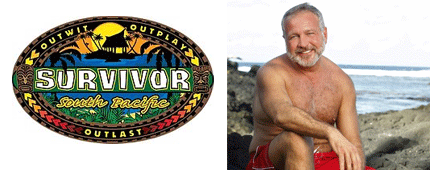Susanna Lo stands over a body slumped in a chair, palpable body heat rising from the man drenched in blood. The drops hitting the floor are barely audible.

She takes a dripping knife from a young girl standing nearby, hands it to another girl waiting in the shadows, and unties the ropes that bind the man’s hands…as he opens his eyes and smiles.
“That’s a wrap!” Susanna calls. “Great work, everyone!”
The Los Angeles filmmaker currently is entrenched in the filming of Manson Girls, an independent movie that focuses on the lives of Susan Atkins, Leslie Van Houten, Patricia Krenwinkel, Lynette Fromme, Sandra Good, Linda Kasabian, Mary Brunner, and Catherine Share, better known as the female “inner circle” of Charles Manson’s murderous cult, the Family.
Actress and singer Taryn Manning, who has appeared on Sons of Anarchy, Burn Notice, Get Real, and The Practice along with films such as Crazy/Beautiful and 8 Mile, will portray the most infamous of the girls, Susan “Sadie” Atkins. Tania Raymonde, who played Alex in the television series Lost and appears in Texas Chainsaw 3D this year, is playing knife-wielding vixen Leslie Van Houten.
The award-winning Lo first gained recognition for her 1995 effort, Black & White: A Love Story. She was gracious enough to tolerate a little of my interrogations about her life and the motivations behind her latest project.
FP: Thank you so much for taking the time to spend with me! I am really excited about your upcoming film. Tell me a little about how you got started in filmmaking…do you consider yourself primarily a director? Writer? Producer? All three?
SL: I am primarily a writer/director; I really can’t separate the two categories. I have been making films since I was a six-year-old kid. I started off by taking photographs and writing stories to go with the shots. My dad finally gave in and bought me a super-8 camera when I was seven, and the rest is history. I’ve never considered doing anything else. I learned producing as a necessary means to get my films made, and to understand the business aspects of filmmaking. When I went to film school, it was all guys in my class, and they wouldn’t give me access to the film equipment that was provided at the school. So I had to find a way to get equipment and film for free from the pro shops like Panavision and Deluxe. Those male classmates did me a big favor; I can produce circles around them with no money because I’ve been swimming with sharks since college. And I still have the best relationship with Panavision and Deluxe to this day.

FP: How did Black & White… come about?
SL: When I first started pitching to agents and producers, I kept getting the same response… “You should write a story about being an Asian, immigrant woman who grew up in America.” So I wrote a story about a wealthy black man and a working class white woman instead. It’s not that I object to an Asian, female, immigrant story, but that’s not all I am. I’ve lived all over the world, I speak a lot of languages, but most of all, I am a filmmaker. I don’t see why my race and gender have to be emphasized each time someone refers to me as a director. People don’t call Steven Spielberg a Jewish, male director. They just call him a director.
So that’s how I came up with Black & White: A Love Story.
FP: Can you give us a summary of the piece?
SL: Basically, it’s a Romeo and Juliet love story, shot in 35mm black and white, because I love the medium and I love romance. The couple meets in a blackout in the elevator and never sees each other until after they’ve already decided to go out on their first date.
FP: Were you surprised at the attention it received?
SL: I was very surprised at the attention the film received. We had no budget (it was shot for $42,000; that barely covers production costs, let alone film or developing costs). We had no famous actors, just super talented actors. We had no press or money for press. But somehow, the film was noticed by some great programmers at big film festivals, and also by Variety, who wrote a great review. Ian Birnie, who was the head of MOMA at the time, was really the guy who helped Black & White… get into the Berlin Film Festival. We’ve now become great friends, and he told me that out of 400 films he had to watch, Black & White… was the only film he didn’t hit the fast forward button on. I met Joe Leydon of Variety by accident. Berlin Film Festival is filled with a lot of serious people who are all sharply dressed in black and a bit stand-offish, very intimidating for a 20-something director at her first top festival. Joe was casually dressed and everyone was being a bit snobby to him. We smiled at each other, started chatting away, and he decided to skip the press screening for the director’s cut of The Professional, and viewed Black & White instead. Then he wrote a fabulous review of the film that landed in International Variety’s Berlin Edition.
FP: Let’s talk a little about your current project. When people hear that I am working on a book about Charles Manson‘s cult, the Family, I often am asked why, when so many books and films have already been done about the case. I know what makes my book stand apart, so what about you? What is your upcoming film, Manson Girls, going to convey that has not been said before?
SL: Manson Girls is the first time the story has been told from the perspective of the girls. Everybody focuses on Charlie’s story or (prosecuting attorney and Helter Skelter author Vincent) Bugliosi‘s story. My script is told from the perspective of eight of the girls.
FP: Tell me a little about the cast. Is it true that Lindsay Lohan was originally slated to appear as Brenda?

SL: It’s actually a bit in reverse. After Manson Girls went out into breakdowns for agents and managers to submit actors, a whole slew of copycat films started to pop up in the following weeks. Lindsay was attached to one of those other films. But the articles written about Manson Girls started to get merged with articles about Lindsay, so everyone thought she was a part of Manson Girls. Brenda isn’t even in my script. Ironically, after Taryn Manning joined the cast, she has brought up that Lindsay would be interested in meeting with me and possibly joining Manson Girls.
The cast is simply incredible, from Taryn Manning to Tania Raymonde, who play two of the eight girls, and Eric Balfour and Bill Moseley, who play Bobby Beausoleil and Charles Manson. Many people have posed the thought that Bill is much older than Manson (Moseley is 61 – FP). What they don’t realize is that Manson’s face is never once shown in the film. So Bill Moseley is the perfect choice to play Charlie. He’s one of the few actors who can put out a brilliant performance just using his voice and body gestures.
FP: In your research, have you contacted anyone involved with the case?
SL: Initially, yes. Or so I thought. I was sending emails and Facebook connects to people I believed were a part of the Manson Family. Turns out a lot of these people weren’t the real people. I also noticed that I couldn’t get a similar answer out of anyone who lived through that time. Everyone has a different perspective of the same event. It was a lot like the film Rashomon: one event, a multitude of perspectives. I finally decided to do a lot of research and tell it from my own perspective, as a writer that was inspired by true events. After all, this is not a documentary.
FP: Judging from the title, your film appears to focus more on the female cult members rather than the men, the victims, or Manson himself. Do you see the movie as a cautionary tale?
SL: Yes, it definitely focuses on the girls over the guys, Manson is barely in it. I really had very little interest in him; his story had been told too many times, in my opinion.
Manson Girls is certainly a cautionary tale, one about how America raised a nation of female serial killers, and how history has continued to repeat itself because we don’t seem to learn from it. All you have to do is say the word Columbine to show how we haven’t learned as a society.
FP: Will there be a sympathetic approach to the girls, or do you see them the way the majority of the public views the cult members – as heartless, remorseless killers unable to be rehabilitated?
SL: The film has a sympathetic approach to the girls’ earlier lives…their world before they met Manson. Many of the girls come from a background of neglect, abandonment or abuse, which is what made them so easy for Manson to seduce. Most of the girls did not have adult role models or a strong support system they felt they could rely on. (The period) after the murders is not something that is explored in Manson Girls. The film ends one minute before the Tate/LaBianca murders.
FP: Has filming wrapped? Editing? Is there a projected release date set?
SL: We initially started filming some scenes, which we eventually used to cut into a sizzle reel, when our funding suddenly fell through. As is typical of the independent filmmaking world, even a contract doesn’t guarantee that the money will get into the bank. We are back in the position of looking for new funds to complete the film.
Check out the sizzle reel by clicking here!
FP: How long has this project been in the works?
SL: We initially announced the film back at Sundance in 2011. We put on a terrific concert with the actresses from the cast and members of The Doobie Brothers, who are the film’s composer and soundtrack producers. The music for the soundtrack not only features the cast and The Doobies, but members from The Beach Boys, Jefferson Airplane, Big Brother, Beth Heart, and possibly Susanna Hoffs and Orianthi. It’s a mind-blowing soundtrack!
FP: Let’s talk a little about the woman behind the work. What is one thing about you that people would be surprised to hear?
SL: Most people are surprised that I am pure Chinese and that English is my third language. People simply refuse to believe that I was a blonde, Chinese kid who couldn’t speak a lick of English until I was almost six.
FP: Do you see independent filmmaking as a way to express art often stifled by mainstream film?
SL: Absolutely, I wouldn’t have stuck with it for so long if I felt otherwise…although I’m happy to make a mainstream film and get paid the big bucks as well. I’m not talking about needing a $200 million budget; all I need is $10 million to deliver a film that looks like it cost $200 million!
FP: What about that? Do you have any future projects in the works?
SL: I have quite a few, both film and television projects. I have a television series called Ripper about the Jack the Ripper murders. I have a published novel I’m ready to make the film of called Alma of My Heart. I’ve been working on a film noir called Largo that has been falling in and out of production for years because funders keep “forgetting to put the check in the mail”. I also have a very risqué television series called Good Vibrations – and yes, it’s exactly what you think it’s about.



Excellent post. I definitely appreciate this website. Thanks!
This movie will never depict the horror or the sickness of these women! I met them and sat with them at a late court night at Sybils house…they discussed me with their conversations of killing Sharon Tate…if you weren’t there …you don’t know!!